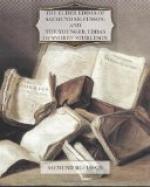PREFACE.
Saemund, son of Sigfus, the reputed collector of the poems bearing his name, which is sometimes also called the Elder, and the Poetic, Edda, was of a highly distinguished family, being descended in a direct line from King Harald Hildetonn. He was born at Oddi, his paternal dwelling in the south of Iceland, between the years 1054 and 1057, or about 50 years after the establishment by law of the Christian religion in that island; hence it is easy to imagine that many heathens, or baptized favourers of the old mythic songs of heathenism, may have lived in his days and imparted to him the lays of the times of old, which his unfettered mind induced him to hand down to posterity.
The youth of Saemund was passed in travel and study, in Germany and France, and, according to some accounts, in Italy. His cousin John Ogmundson, who later became first bishop of Holum, and after his death was received among the number of saints, when on his way to Rome, fell in with his youthful kinsman, and took him back with him to Iceland, in the year 1076. Saemund afterwards became a priest at Oddi, where he instructed many young men in useful learning; but the effects of which were not improbably such as to the common people might appear as witchcraft or magic: and, indeed, Saemund’s predilection for the sagas and songs of the old heathen times (even for the magical ones) was so well known, that among his countrymen there were some who regarded him as a great sorcerer, though chiefly in what is called white or innocuous and defensive sorcery, a repute which still clings to his memory among the common people of Iceland, and will long adhere to it through the numerous and popular stories regarding him (some of them highly entertaining) that are orally transmitted from generation to generation.[1] Saemund died at the age of 77, leaving behind him a work on the history of Norway and Iceland, which is now almost entirely lost.
The first who ascribed to Saemund the collection of poems known as the Poetic Edda,[2] was Brynjolf Svensson, bishop of Skalholt. This prelate, who was a zealous collector of ancient manuscripts, found in the year 1643, the old vellum codex, which is the most complete of all the known manuscripts of the Edda; of this he caused a transcript to be made, which he entitled Edda Saemundi Multiscii. The transcript came into the possession of the royal historiographer Torfaeus; the original, together with other MSS., was presented to the King of Denmark, Frederick. III., and placed in the royal library at Copenhagen, where it now is.[3] As many of the Eddaic poems appear to have been orally transmitted in an imperfect state, the collector has supplied the deficiencies by prose insertions, whereby the integrity of the subject is to a certain degree restored.
The collection called Saemund’s Edda consists of two parts, viz., the Mythological and the Heroic. It is the former of those which is now offered to the public in an English version. In the year 1797, a translation of this first part, by A.S. Cottle, was published at Bristol. This work I have never met with; nor have I seen any English version of any part of the Edda, with the exception of Gray’s spirited but free translation of the Vegtamskvida.




